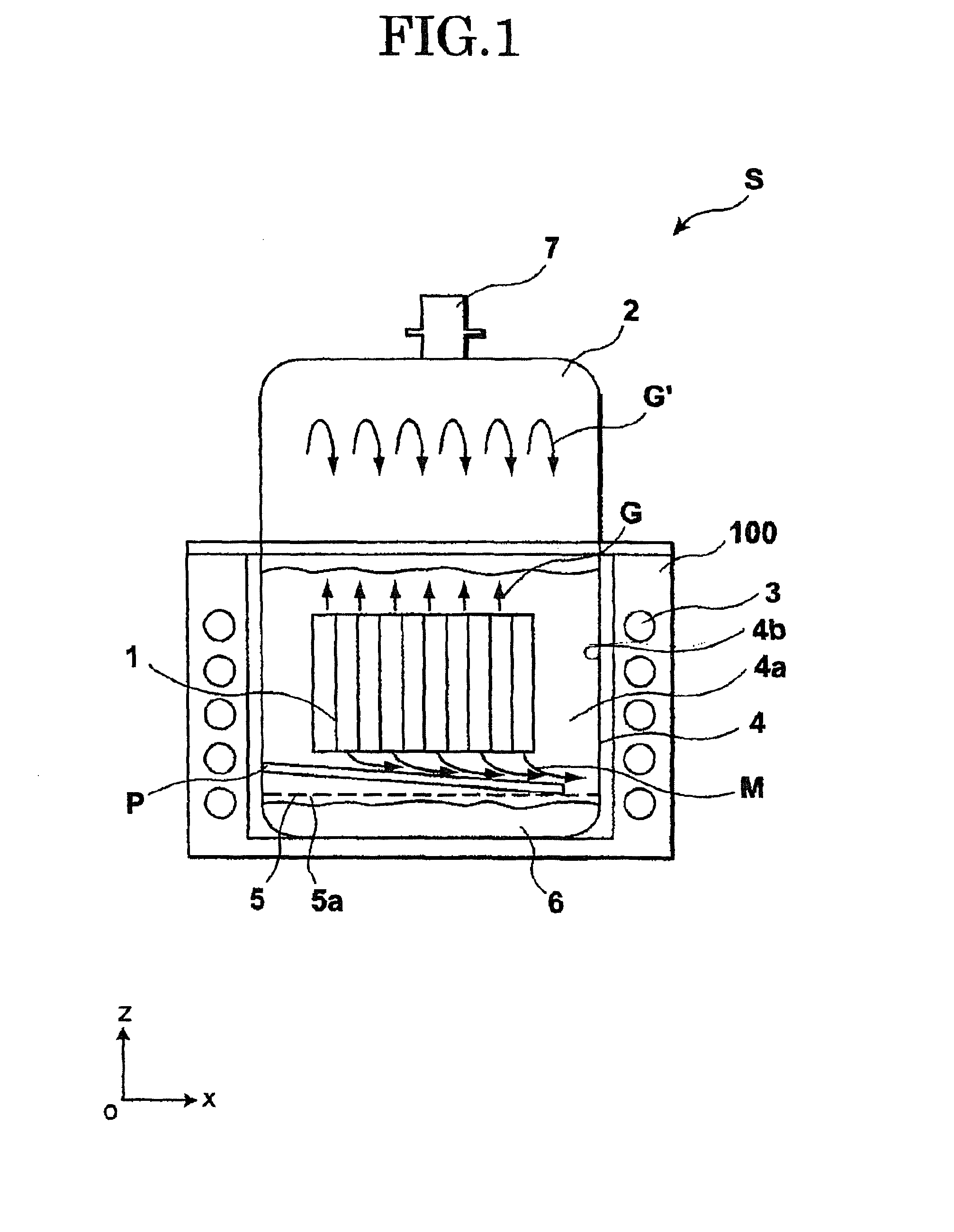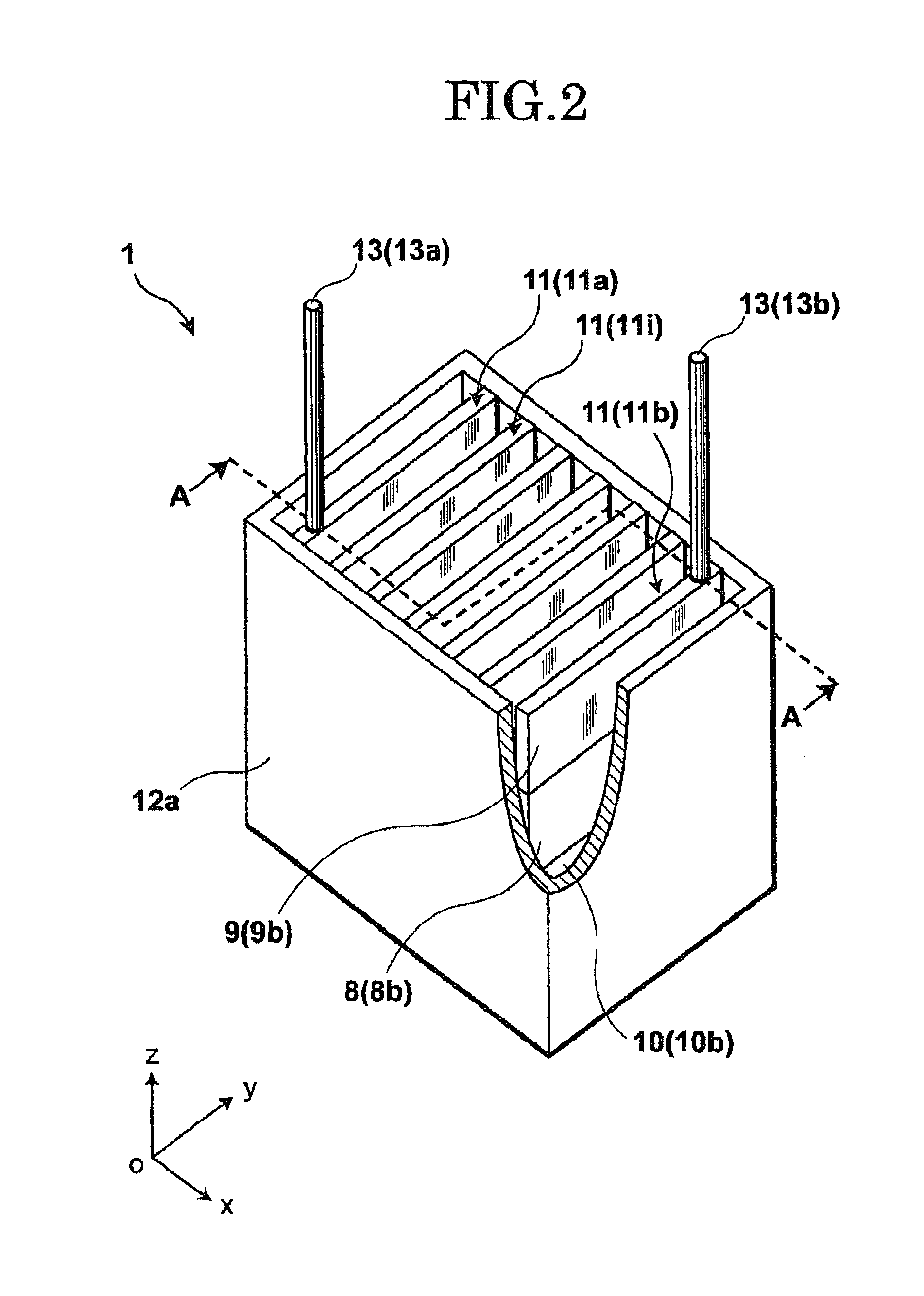Electrolysis system and method
a technology of electrolysis system and electrode, applied in the direction of electrolysis components, electrolysis organic production, separation processes, etc., can solve the problems of drop in electrolysis efficiency, leakage current flowing from the electrode to other areas, and clogging of the delivery pipe, so as to reduce the ohmic loss, improve the efficiency of electrolysis current, and achieve effective electrolysis
- Summary
- Abstract
- Description
- Claims
- Application Information
AI Technical Summary
Benefits of technology
Problems solved by technology
Method used
Image
Examples
first modified example
[0136]An electrode unit 41 of the first modified example of the present embodiment shown in FIG. 4 differs from the structure of the electrode unit shown in FIG. 3 mainly in that the lower insulation members 10 have discharge flow passages 16, respectively, each extending in the vertical direction.
[0137]As set forth above, upon electrolysis reaction, electrolysis product gas G is generated at the anode surface portions 14 and moves upward whereas melt metal M in the form of electrolysis product metal is generated at the cathode surface portions and moves downward. Upon further study, if an attempt is made to mount the insulation members 9 and 10 on the electrodes 8, respectively, and allow the electrodes 8 to be spaced from each other with a progressively decreasing distance, an ohmic loss and a leakage current decrease with a resultant decrease in electrolysis voltage. However, resulting melt metal M tends to adhere to surfaces of the cathode surface portions 15 at lower ends there...
second modified example
[0143]An electrode unit 51 of a second modified example of the present embodiment, shown in FIG. 5, differs in structure from the electrode unit 41 of the first modified example, shown in FIG. 4, mainly in that the upper insulation members 9 have one sides formed with protruding portions 9p, respectively, which jut toward the proximal neighboring upper insulation members 9 so as to protrude with respect to the cathode surface portions 15 of the electrodes 8, respectively. In addition, the end electrode 8b has no cathode surface portion 15 and hence, the protruding portion 9p can be omitted from the upper insulation member 9b associated with the end electrode 8b. Of course, further, such protruding portions 9p of the upper insulation members 9 may be provided in the electrode unit 1 shown in FIG. 3.
[0144]With such a structure of the present modified example, like the structure determined in the lower insulation members 10 of the first modified example, a distance d′ between the upper...
third modified example
[0146]An electrode unit 61 of a third modified example of the present embodiment, shown in FIG. 6, differs in structure from the electrode unit 51 of the second modified example, shown in FIG. 5, mainly in that the electrodes 8 and the upper and lower insulation members 9 and 10, associated with the electrodes 8, respectively, are inclined by an angle θ with respect to the vertical direction such that the anode surface portions face downward and the cathode surface portions face upward. In addition, such inclining placements of the electrodes 8 may be applied to the electrode units 1 or 41 shown in FIG. 3 or FIG. 4.
[0147]With such a structure, slightly inclining the cathode surface portions 15 of the electrodes 8 so as to face upward enables electrolysis product gas G and electrolysis product metal M to be strongly constrained toward the anode surface portions 14 and the cathode surface portions 15, respectively. That is, anode product gas G is subjected to a force acting upward due...
PUM
| Property | Measurement | Unit |
|---|---|---|
| melting point | aaaaa | aaaaa |
| melting point | aaaaa | aaaaa |
| melting point | aaaaa | aaaaa |
Abstract
Description
Claims
Application Information
 Login to View More
Login to View More - R&D
- Intellectual Property
- Life Sciences
- Materials
- Tech Scout
- Unparalleled Data Quality
- Higher Quality Content
- 60% Fewer Hallucinations
Browse by: Latest US Patents, China's latest patents, Technical Efficacy Thesaurus, Application Domain, Technology Topic, Popular Technical Reports.
© 2025 PatSnap. All rights reserved.Legal|Privacy policy|Modern Slavery Act Transparency Statement|Sitemap|About US| Contact US: help@patsnap.com



